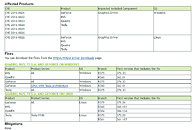Raevenlord
News Editor
- Joined
- Aug 12, 2016
- Messages
- 3,755 (1.15/day)
- Location
- Portugal
| System Name | The Ryzening |
|---|---|
| Processor | AMD Ryzen 9 5900X |
| Motherboard | MSI X570 MAG TOMAHAWK |
| Cooling | Lian Li Galahad 360mm AIO |
| Memory | 32 GB G.Skill Trident Z F4-3733 (4x 8 GB) |
| Video Card(s) | Gigabyte RTX 3070 Ti |
| Storage | Boot: Transcend MTE220S 2TB, Kintson A2000 1TB, Seagate Firewolf Pro 14 TB |
| Display(s) | Acer Nitro VG270UP (1440p 144 Hz IPS) |
| Case | Lian Li O11DX Dynamic White |
| Audio Device(s) | iFi Audio Zen DAC |
| Power Supply | Seasonic Focus+ 750 W |
| Mouse | Cooler Master Masterkeys Lite L |
| Keyboard | Cooler Master Masterkeys Lite L |
| Software | Windows 10 x64 |
If you're one of those people who doesn't regularly update their graphics card drivers, and you're rocking an NVIDIA graphics card, you really should update your drivers to the latest WHQL version, 376.33. The release notes and a security bulletin issued by the company point towards the fixing of multiple detected kernel layer (nvlddmkm.sys) vulnerabilities in NVIDIA's previous driver releases, which could "Lead to a Denial of Service, Escalation of Privileges, or Both".
In total, there are seven reported vulnerabilities as having been fixed, with NVIDIA acknowledging contributions in the issues' detection from engineers with Google Project Zero and Cisco Talos.

View at TechPowerUp Main Site
In total, there are seven reported vulnerabilities as having been fixed, with NVIDIA acknowledging contributions in the issues' detection from engineers with Google Project Zero and Cisco Talos.

View at TechPowerUp Main Site









